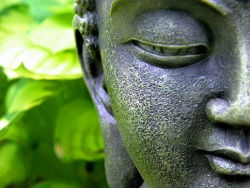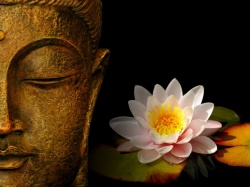The Dhyana-Samadhi Meditation Absorptions - Part 10
OTHER SAMADHI ATTAINMENTS
Esoteric Buddhism is famous for the displays of various samadhi powers. All the great masters of Esoteric Buddhism, whether they were from the Red, Yellow or other sects, followed a strict regimen of cultivation to reach their stage of spiritual attainment. The reason they were able to attain great levels of kung-fu was because they mastered various samadhi. Of course, whether they could achieve the ninth samadhi of the Arhats, or complete enlightenment beyond even that, is another matter entirely, but for now we must re-emphasize that the eight lower concentrations are commonly shared by all genuine cultivation schools.
When heavenly beings, demons, asuras or animals spiritually cultivate, they also follow the general principles and order of the eight samadhi; there is no way to avoid them on the proper road of spiritual practice. These are, in actuality, the various templates of spiritual practice. You must therefore understand these stages of attainment to comprehend either your own or another's meditative progress on the spiritual path.
In terms of basic physical cultivation kung-fu, in addition to trying to master the various samadhi, it is also correct to say that you cannot get away from the fundamental basics of "cultivating your chi and mai" on the spiritual road, which actually means "transforming your chi and mai."
But if you actively set out to cultivate the chi, the mai, chakras, bright points and kundalini, the very best you could ever hope to do
is to arrive at the third dhyana.
If through your cultivation efforts you can achieve the first and second dhyana, it is certain that your chi and mai will have already been transformed and your kundalini already initiated. Nevertheless, achieving the first and second dhyana is no guarantee that you will be able to arrive at the third dhyana.
The third dhyana is still involved with the physical bliss of physical form, so any sort of materialistic cultivation can, at the utmost, only take you as far as this stage of cultivation, if at all. This is an extremely important point to consider in your cultivation practice, and a reason why most practitioners of the Esoteric school fail in their cultivation practice.
It would be terrible to waste your time and efforts targeting yourself at just this incomplete degree of attainment. Hence one should not devote themselves to cultivating the physical body, but should aim for mental attainments instead. And if one shoots for mental attainments, they will certainly end up cultivating their physical nature, but they will not be able to totally abolish disease unless they reach the realm of the third dhyana.
Now before we return to discuss the five skandhas in detail as a means of measuring your stage of spiritual achievement, we should once again review the stories of Han Shan on Wu Tai Mountain, and the Taiwanese master Guang Qin. With what we already know, we must ask ourselves what samadhi these individuals had achieved?
For instance, if you sit in meditation yourself, and a certain amount of time goes by without your knowing it, and you can only be aroused from your samadhi by the sound of a bell--is this the samadhi of no-thought, the samadhi of nothingness, or the samadhi of drowsiness?
A related question is the following: When you reach a state in which you know nothing, are you actually in a state of samadhi and if so, which samadhi? Is it correct to say that the goal of spiritual cultivation is to reach the state in which you know nothing? As to the story of Hui-yuan's dharma brother, who remained in samadhi for so long that a tree grew up around him, what type of samadhi was this … and if you can personally attain this type of samadhi, can we accurately say that your chi mai are all open?
To answer at least one question straight off the bat, if your chi mai are not open then it is difficult to sleep for even twenty-four hours straight, so a person's chi mai must be open if they are able to remain in samadhi for several hundred years! But what about the type of situation where you do not have to eat for a week--are your chi mai all opened in this situation? And as to the term we sometimes find in Chinese called the "samadhi of drowsiness," if you are drowsy then you cannot be in samadhi, so why do people use this term and call it a "samadhi"?
Also, is it physically possible for a person to be so drowsy that they will actually sleep for several continuous days, which is in some ways similar to sitting in continuous samadhi? In fact, modern medicine does recognize certain sleeping diseases where you can actually sleep yourself to death. In these cases, you will sleep until you die. So when we come across the term, "samadhi of drowsiness," it does not mean the samadhi of cultivation. Rather, it is just a literary term and title.
Sitting in meditation cannot be considered samadhi, either, because "sitting practice" is just maintaining a special posture for a fixed period of time in order that you can thereby better reach an experiential realm of samadhi. If your body becomes calm and no longer bothers you, we also colloquially call this "body samadhi." Doing sitting practice is just a way, or just a means of practice, to help you achieve mental samadhi but the practice of sitting itself is not samadhi. This is what Zen master Huai-jang told his student Ma-tsu. If sitting in meditation were samadhi, we would all simply sit down and then experience all these great experiential realms. But who does?
All these issues have to be solved, and they are all very serious issues regarding the cultivation of samadhi, prajna wisdom, and discipline. To start, we can say that if knowing nothing is samadhi, then all the rocks in a quarry are also in samadhi. In fact, if knowing nothing constitutes samadhi, then all these rocks would be at a higher stage of cultivation attainment than we are! If you simply eat the right pills today, you can also get to the state where you do not have to eat for a week either, so we can dismiss these two misconceptions as the samadhi of true cultivation attainment.
As mentioned previously, there are actually several scenarios where you do not know what is going on because your thoughts are arrested, and you can reach a state of mindlessness in these states of deep sleep, unconsciousness, the samadhi of no-thought, the heaven of no-thought, the samadhi of extinction, and the stage of complete nirvana. Does Buddhism recognize these various stages? Of course, but the question is, what type of experiential realm do they really represent?
If you want to cultivate toward self-realization, the eight samadhi are the standard means for approaching the path. This is the case no matter which particular spiritual school you follow. This is why, in fact, the eight samadhi are called "common spiritual methods" or common levels of cultivation attainment--the higher gods and lower animals all cultivate these very same realms. But if you do not understand the theory behind these meditative stages, it is very easy to take the route of outside paths that do not lead to enlightenment.
This is precisely why most yogis fall short of the Tao. Lacking the proper teachings entirely, Western monks, nuns, priests, reverends, rabbis and mullahs are in even worse shape despite their spiritual hopes and aspirations. They are in worse shape because they do not know the proper spiritual teachings and practices, and hence they tend to go astray in their spiritual practice. This is why to learn the path to Tao, most everyone of spiritual attainment in the past ended up going to learn from the East.
What is the meaning of the "outside paths" of cultivation? The term "outside path" does not refer to the fact that a path is outside of Buddhism. Buddhism itself, for instance, is considered an outside path of the Vedas. Rather,
an "outside path" means a cultivation path wherein you are searching for dharma, but you are searching for enlightenment outside the mind.
You will never find Enlightenment searching outside of the mind, which is why an outside path is a deviant road of practice. As to the paths we refer to as "the devil's Tao,"
the "devil roads" are cultivation pathways where you remain confused and ignorant, pathways wherein you cannot master yourself.
Even though they are being adulated today, shamanic trances and hypnotic states are examples that fall into this category of spiritual deviation. These roads seem to have great appeal today, especially to academics trying to do research and write papers, but they are actually experiential realms where you are not in control of the mind, and they do not ever lead to spiritual enlightenment or any of the dhyana. They are not the path of Tao in any way, shape or form.
You can therefore understand that the cultivation practice of psychics who fall into trances, such as Edgar Cayce, are considered "outside paths" even though du-yin type abilities have sometimes provided the world with useful information. These are not genuine pathways of spiritual cultivation because they are not pathways to self-realization, and so they do not constitute proper pathways of spiritual practice! In a sense you can simply call them deviant practices. People may desire these things, but they are lusting after the wrong targets.
While the material offered by shamans and those who fall into trances or "channel" information to us may actually at times be quite useful, it is actually a crime to call these "pathways of spiritual cultivation." When people cultivate to have an OOBE (out-of-the body-experience) through astral projection, this is not the pathway of spiritual cultivation, either. In fact, this popular practice of trying to have an "astral projection" is quite harmful because it tends to destabilize the individual and can lead to rebirth as a wandering ghost or asura! The people who attain these abilities only know of this one life, and they do not see the long term consequences of this sort of misguided practice.
Ordinary individuals do not understand these issues clearly due to their own lack of cultivation attainment, so they are easily misled. It is difficult to understand the nature of the du-yin side of the sixth consciousness, but the ability to project the mind out of the body is actually an achievement on the borderline between sanity and mental illness. Why would you want to cultivate such a thing? Chasing after auras, hypnotic regressions, superpowers, channeling, trances, trying to open chakras--we could go on and on citing various mistaken practices. The point is, none of these practices constitute the true cultivation path, or a true spiritual path. They are all just tumors of the genuine spiritual traditions.



